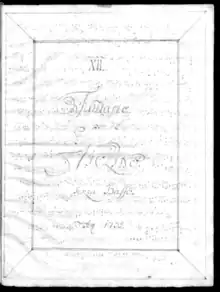
Georg Philipp Telemann's collection of 12 Fantasias for Solo Violin, TWV 40:14–25, was published in Hamburg in 1735. It is one of Telemann's collections of music for unaccompanied instruments, the others being twelve fantasias for solo flute and thirty-six for solo harpsichord that were published in Hamburg in 1732–33, as well as a set of twelve fantasias for solo viola da gamba that was published in the same city in 1735, but were considered lost until a copy of the print was found in a private collection in 2015 by viola da gamba player and musicologist Thomas Fritzsch.[1]
This collection consists of the following works:
- Fantasia in B-flat major (Largo—Allegro—Grave—Si replica l'allegro)
- Fantasia in G major (Largo—Allegro—Allegro)
- Fantasia in F minor (Adagio—Presto—Grave—Vivace)
- Fantasia in D major (Vivace—Grave—Allegro)
- Fantasia in A major (Allegro—Presto—Allegro—Presto—Andante—Allegro)
- Fantasia in E minor (Grave—Presto—Siciliana—Allegro)
- Fantasia in E-flat major (Dolce—Allegro—Largo—Presto)
- Fantasia in E major (Piacevolumente—Spirituoso—Allegro)
- Fantasia in B minor (Siciliana—Vivace—Allegro)
- Fantasia in D major (Presto—Largo—Allegro)
- Fantasia in F major (Un poco vivace—Soave—Da capo un poco vivace—Allegro)
- Fantasia in A minor (Moderato—Vivace—Presto)
This scheme does not resemble that of the twelve flute fantasies, which progress in a roughly stepwise direction from A major to G minor.[2] However, some overall structure seems to be implied: the first movement of Fantasia 7 subtly references the opening of the first fantasia in the collection, indicating that Telemann possibly conceived this work as two groups of 6 fantasias. He has, indeed, described the collection as "12 fantasias ... of which 6 include fugues and 6 are Galanterien", with "fugues" referencing the contrapuntal style of certain fantasias.[3]
Telemann's violin fantasias exhibit mastery of not only compound melodic lines, but also of idiomatic writing for violin,[4] as Telemann himself was a self-taught violinist. Much of the music reveals the influence of Italian sonatas and concertos, but the typical tendency of German solo violin music to rely on polyphony is still present:[5] fantasias 2, 3, 5, 6, and 10 all include fugues and employ much double-stopping.
References
Notes
Sources
- Anon. (2015-08-10). "Sensationelle Wiederentdeckung". Zentrum für Telemann-Pflege und -Forschung Magdeburg. Retrieved 2016-02-21.
- Parish, Carl (2000). A Treasury of Early Music. Courier Dover Publications. ISBN 978-0-486-41088-3.
- Zohn, Steven (2001). "Georg Philipp Telemann". In Sadie, Stanley; Tyrrell, John (eds.). The New Grove Dictionary of Music and Musicians (2nd ed.). London: Macmillan Publishers. ISBN 978-1-56159-239-5.
- Zohn, Steven (2008). Music for a Mixed Taste: Style, Genre, and Meaning in Telemann's Instrumental Works. US: Oxford University Press. ISBN 978-0-19-516977-5.